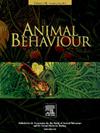Light modulates population differences in alternative mating tactics in Trinidadian guppies
IF 2.3
2区 生物学
Q2 BEHAVIORAL SCIENCES
引用次数: 0
Abstract
A major goal in evolutionary biology is to understand how trade-offs between natural and sexual selection drive the evolution and maintenance of secondary sexual traits. Many organisms exhibit bright, conspicuous colour signals to attract mates, but these signals often come at the cost of increased predation. One way to reduce predation risk is to adjust behaviour according to circadian changes in the local light environment because light determines the perceived conspicuousness of a visual signal. In this study we consider how male mating behaviours change throughout the day in two groups of Trinidadian guppies, Poecilia reticulata, adapted to different levels of predation risk. Using outdoor stream mesocosms, we found that fish adapted to higher predation risk reduced their conspicuous courtship display during midday high-light conditions but increased courtship in the morning and evening conditions. In contrast, low-predation guppies courted in the morning but not in the evening. Males from both habitats reduced courtship when it was brighter, but high-predation males were more sensitive to brightness and hue variations in the morning and evening hours. These results highlight the importance of light environment on courtship display strategies and its consequences on the evolution of sexually selected traits.
光调节特立尼达孔雀鱼在不同交配策略上的种群差异
进化生物学的一个主要目标是了解自然选择和性选择之间的权衡如何驱动第二性征的进化和维持。许多生物表现出明亮、显眼的颜色信号来吸引配偶,但这些信号往往是以增加捕食为代价的。减少捕食风险的一种方法是根据当地光环境的昼夜变化来调整行为,因为光决定了视觉信号的感知显著性。在这项研究中,我们考虑了两组特立尼达孔雀鱼(Poecilia reticulata)的雄性交配行为如何在一天中发生变化,以适应不同程度的捕食风险。利用室外溪流中生态系统,我们发现适应较高捕食风险的鱼类在正午强光条件下减少了明显的求爱行为,但在早晨和晚上的条件下增加了求爱行为。相比之下,低捕食性的孔雀鱼在早上求爱,而不是在晚上。当光线较亮时,两种栖息地的雄性都减少了求偶行为,但高捕食率的雄性对早晚的亮度和色调变化更敏感。这些结果强调了光环境对求偶表现策略的重要性及其对性选择特征进化的影响。
本文章由计算机程序翻译,如有差异,请以英文原文为准。
求助全文
约1分钟内获得全文
求助全文
来源期刊

Animal Behaviour
生物-动物学
CiteScore
4.60
自引率
8.00%
发文量
236
审稿时长
10.2 weeks
期刊介绍:
Growing interest in behavioural biology and the international reputation of Animal Behaviour prompted an expansion to monthly publication in 1989. Animal Behaviour continues to be the journal of choice for biologists, ethologists, psychologists, physiologists, and veterinarians with an interest in the subject.
 求助内容:
求助内容: 应助结果提醒方式:
应助结果提醒方式:


